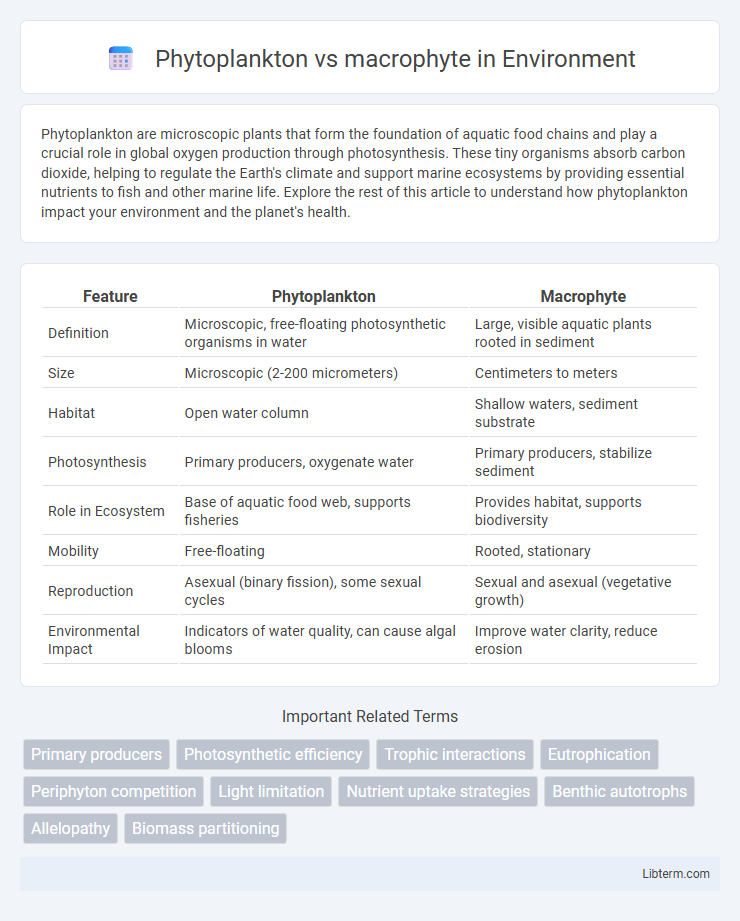Phytoplankton are microscopic plants that form the foundation of aquatic food chains and play a crucial role in global oxygen production through photosynthesis. These tiny organisms absorb carbon dioxide, helping to regulate the Earth's climate and support marine ecosystems by providing essential nutrients to fish and other marine life. Explore the rest of this article to understand how phytoplankton impact your environment and the planet's health.
Table of Comparison
| Feature | Phytoplankton | Macrophyte |
|---|---|---|
| Definition | Microscopic, free-floating photosynthetic organisms in water | Large, visible aquatic plants rooted in sediment |
| Size | Microscopic (2-200 micrometers) | Centimeters to meters |
| Habitat | Open water column | Shallow waters, sediment substrate |
| Photosynthesis | Primary producers, oxygenate water | Primary producers, stabilize sediment |
| Role in Ecosystem | Base of aquatic food web, supports fisheries | Provides habitat, supports biodiversity |
| Mobility | Free-floating | Rooted, stationary |
| Reproduction | Asexual (binary fission), some sexual cycles | Sexual and asexual (vegetative growth) |
| Environmental Impact | Indicators of water quality, can cause algal blooms | Improve water clarity, reduce erosion |
Introduction to Phytoplankton and Macrophytes
Phytoplankton are microscopic, photosynthetic organisms drifting in aquatic environments, crucial for oxygen production and forming the base of the aquatic food web. Macrophytes are large, visible aquatic plants rooted in sediments, providing habitat structure and influencing nutrient cycling in freshwater and marine ecosystems. Both groups play essential roles in maintaining water quality and supporting biodiversity in aquatic habitats.
Biological Characteristics and Structure
Phytoplankton are microscopic, unicellular organisms with simple structures primarily consisting of chloroplasts for photosynthesis, floating freely in aquatic environments. Macrophytes are larger, multicellular plants with complex tissues such as roots, stems, and leaves, enabling them to anchor in sediment and support diverse biological functions. The cellular simplicity of phytoplankton contrasts with the specialized vascular and supportive tissues present in macrophytes, reflecting their distinct ecological roles and adaptations.
Habitats and Distribution
Phytoplankton predominantly inhabit open water columns of oceans, lakes, and rivers, thriving in well-lit surface waters where nutrients are abundant. Macrophytes occupy shallow coastal zones, freshwater wetlands, and riverbanks, rooted in sediments with access to sunlight for photosynthesis. Distribution of phytoplankton fluctuates with nutrient availability and water temperature, while macrophyte presence depends on substrate type, water depth, and flow conditions.
Role in Aquatic Ecosystems
Phytoplankton play a crucial role in aquatic ecosystems as primary producers, forming the base of the food web and supporting diverse marine life with oxygen through photosynthesis. Macrophytes, large aquatic plants, contribute to habitat complexity, stabilize sediments, and enhance water quality by absorbing nutrients and providing shelter for fish and invertebrates. Both phytoplankton and macrophytes are vital for nutrient cycling and maintaining ecosystem balance in freshwater and marine environments.
Photosynthesis and Nutrient Uptake
Phytoplankton perform photosynthesis primarily in the euphotic zone of aquatic environments, utilizing sunlight and dissolved nutrients like nitrogen and phosphorus for rapid growth and oxygen production. Macrophytes, larger aquatic plants, conduct photosynthesis using chloroplasts in submerged leaves, often accessing nutrients both from water and sediment through extensive root systems, enhancing nutrient uptake efficiency. Their differing nutrient uptake strategies influence ecosystem productivity and biogeochemical cycling in freshwater and marine habitats.
Ecological Interactions and Competition
Phytoplankton and macrophytes engage in complex ecological interactions, competing primarily for light, nutrients, and space within aquatic ecosystems. Phytoplankton, microscopic photosynthetic organisms, thrive in open water and rapidly utilize nutrients like nitrogen and phosphorus, often leading to algal blooms that can suppress macrophyte growth through light attenuation. Macrophytes, larger aquatic plants, stabilize sediments and provide habitat structure, influencing water chemistry and competing by shading phytoplankton, thereby shaping community dynamics and ecosystem productivity.
Impact on Water Quality
Phytoplankton can rapidly increase nutrient levels in water through algal blooms, often leading to oxygen depletion and decreased water clarity. Macrophytes enhance water quality by stabilizing sediments, reducing turbidity, and absorbing excess nutrients, thus preventing eutrophication. The balance between phytoplankton and macrophytes is crucial for maintaining healthy aquatic ecosystems and preventing water quality degradation.
Adaptations to Environmental Changes
Phytoplankton exhibit rapid reproductive cycles and flexible metabolic pathways, enabling swift adaptation to fluctuating light, nutrient availability, and temperature changes in aquatic environments. Macrophytes develop extensive root systems and structural modifications such as aerenchyma tissue to cope with waterlogged soils, varying salinity, and sediment accumulation. Both groups employ physiological and morphological adaptations that optimize survival and growth under dynamic ecological conditions.
Importance in Food Webs
Phytoplankton are primary producers that form the base of aquatic food webs, supplying essential nutrients and oxygen through photosynthesis, supporting zooplankton and higher trophic levels such as fish. Macrophytes contribute to habitat complexity and provide shelter and breeding grounds for various aquatic organisms, influencing species diversity and energy flow. Both phytoplankton and macrophytes play crucial roles in nutrient cycling and maintaining ecosystem stability in freshwater and marine environments.
Implications for Conservation and Management
Phytoplankton and macrophytes play crucial roles in aquatic ecosystems, with phytoplankton driving primary productivity and macrophytes providing habitat structure and nutrient regulation. Effective conservation strategies must balance controlling phytoplankton blooms, often caused by nutrient pollution, with protecting macrophyte beds that support biodiversity and stabilize sediments. Management approaches integrating water quality monitoring, nutrient load reduction, and habitat restoration can sustain ecosystem functions and enhance resilience against eutrophication.
Phytoplankton Infographic

 libterm.com
libterm.com